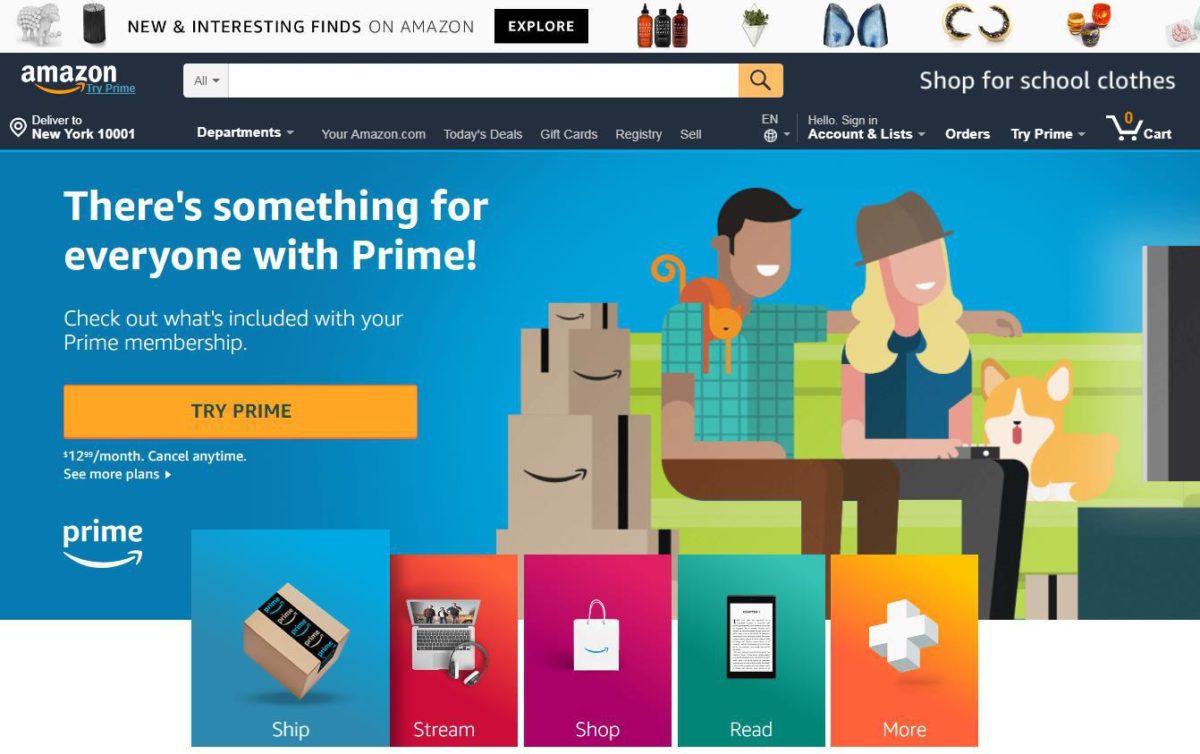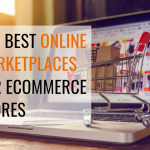As Amazon continues to expand, it would appear that this giant is the defacto shopping center of the internet.
In terms of traffic, Amazon’s beaten eBay –and is still continuing to grow. And e-commerce sellers are jumping on the bandwagon in droves. Independent sellers account for over 45 percent of the total number of items sold on Amazon –and their sales are growing even faster than Amazon’s!
And their customer base is growing too. At last count, Amazon had 310 million active customers –and 90 million U.S. Amazon Prime subscribers. Additionally, according to marketing company BloomReach, over half of all Americans now go to Amazon to carry out their first search for products, choosing Amazon over search engines and other online retailers.
With statistics like these, you might be tempted drop everything and rush over to the platform to set up shop today. But while there are indeed perks to using the platform –namely, immediate access to almost 2 million shoppers, there are also some pitfalls that you should be aware of when calculating the potential gains and risks.
The truth is that Amazon’s not for everyone. For all of its good, there are some reasons for e-commerce stores to be wary of this monolith.
At the very least, the decision to sell on Amazon is one that you’ll want to make carefully, keeping a few important variables in mind.
Let’s look at those now.
Selling on Amazon: The Pros

First, let’s look at some of the positive aspects of selling on Amazon.
Access to a Large Customer Base
First up, something that everyone knows. Selling on Amazon could give you access to a whole new world of potential customers. As of December 2017, Amazon had an average of 197 million visitors per month. Having access to a customer pool like this could mean great things for your business, namely, getting your products in front a lot more eyes.
Great for Companies With Unique Products
For those who offer unique or specialty products, Amazon could be a game changer. The Amazon marketplace is great for moving those unique products. After all, where else are you going to turn when you need that one rare upside-down-umbrella-tea-infuser or bacon-flavored-floss that no one else seems to stock? Amazon, of course. With Amazon you can get your one of a kind item in front of people who will be interested in it.
Strong Features
Amazon reportedly spends some $13 billion per year on research and development, and it’s got some good B2B features to show for it. Its site offers a seamless UX and is constantly being adjusted to increase sales.
Simplified Order Fulfillment
If you’re looking to automate many aspects of your business, Amazon could be a great option. If you choose, you can have Amazon can fulfill your orders with Fulfillment by Amazon (FBA). With this option you can ship your products to Amazon’s warehouse and whenever you make a sell, Amazon will take care of all of the entire order fulfillment process for you. They can also handle refunds, returns, and other aspects of customer service as well.
Selling on Amazon: Cons

While selling on Amazon can generate substantial revenue, it’s not without its challenges –and downsides. Amazon, despite its popularity has a dark side as well. Here’s a look at some of the pitfalls and potential problems that you might face if you decide to use this platform.
There’s Fierce Competition
The most obvious downside to using this platform: competition. One of the main issues with Amazon is that it has a very low entry barrier. It’s very easy to set up shop on Amazon. Unfortunately, though, this also means that it’s easy for everyone else to do exactly the same thing –and there’s a good chance that you’ll be up against plenty of competition.
Bigger competition can lead to bigger problems such as other sellers copying your products or sale ideas. While this isn’t a problem if you’re selling products that are unique, for all other sellers, it’s easy enough for there to be a glut of people all selling the same things. And since Amazon sellers use automated repricing software to continually adjust their prices to be the lowest, there’s a constant battle to out-price one another in a race to the bottom.
Ultimately, the only winners are those who are able to secure the product at the lowest price, or are willing to accept a very small profit margin.
It’s Difficult to Build a Positive Profile
If you thought it was difficult to receive feedback on platforms like eBay, Amazon’s much worse. Only about 1-in-30 Amazon sellers leave reviews, compared to about 1-in-3 on eBay. Ultimately, it’s positive feedback that builds your profile and makes you more attractive to potential buyers. Sadly, it’ll take a while to boost your reviews on Amazon.
The Fees Are High
Selling on Amazon means giving up margin. Depending on the product category, Amazon fees typically range from 6% to 20% of a product’s selling price, with the average seller paying 15%. This doesn’t include the monthly fee of $39.99. With eBay, fees only account for approximately 15% of the sale price. Keep in mind also, that with FBA the fees are even higher. You can expect to pay fees for packing, shipping and handling, customer service, returns, and storage.
There’s a Lot of Admin Work Involved
Listing products can be time-consuming on Amazon. Each category has its own rules that you must adhere to, and you should be prepared to devote a significant amount of time on data entry and admin as well. It can take a while to get new products set up.
It’s Difficult to Grow Your Brand on Amazon
On Amazon, they are the brand, and they see the customers as theirs as well. It’s set up to give you minimal opportunity to grow your own brand, communicate with your customers, and build relationships with them. On Amazon, buyers can search for the lowest cost items, and that’s as far as you’ll be able to go in terms of differentiating yourself from the competition.
While this doesn’t matter so much from a short-term perspective, it can be problematic long-term. As Neil Patel says in his Marketing School episode, Should You Sell Your Products Through Amazon or on Your Own Website, “At the end of the day, you’re not building a business, because you’re not collecting those customers, you’re not adding additional value to them.”
Your Products Can Become Unsellable at Any Time
You’ll also want to keep in mind that your products could become unsellable at any time should Amazon make a change that renders them obsolete. Consider the fact that Amazon works closely with different manufacturers and brands and if one decides suddenly that they don’t want third-parties selling their items on Amazon, they can restrict them.
“I experienced this numerous times on Amazon,” writes Aron Hsiao, former eBay employee and a longtime eBay buyer and seller. “For example, I was selling Dunkin Donuts coffee that I was purchasing at grocery stores and Target. I had about 40 bags in a Fulfillment by Amazon (FBA) warehouse.
One day I received an email that Amazon had partnered with Dunkin Donuts and third-party sellers could no longer sell this brand.” In the end, Hsiao had to pay to get the coffee out of Amazon’s warehouse and sent back to him.
You Could be Banned by Amazon at Any Time
It’s not just your products that could become obsolete, there’s always a risk that you could too. There have been cases where Amazon seller accounts have been suspended, without warning, and the sellers had tremendous difficulty getting them back. While the reasons may be logical to Amazon, it can be a frustrating part of the Amazon seller experience.
If you’ve been blocked, even temporarily and have thousands of dollars’ worth of inventory tied up, this could obviously be a tremendous financial blow. To make matters worse, when it suspends an account, Amazon isn’t always clear on the reasons why.
Take a look at long-time Amazon seller Josh Stankler’s account of having his Amazon account shut down unexpectedly. He says that he was never informed of the exact reason that his account was suspended, and Amazon’s communication with him was very poor. This is perhaps one of the biggest reasons that you’ll want to exercise care in selling on Amazon, being careful not to put all of your eggs in one basket.
While there are pros and cons to building a profile with Amazon, the bottom line depends on your company, your products, and your end goal. Ensure that you go into it with enough education on the topic and you could make it work in your favor.
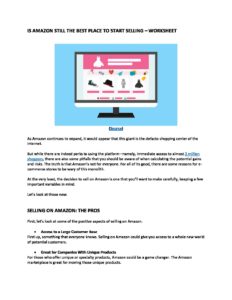
Get our Is Amazon Still the Best Place to Start Selling Worksheet delivered right to your inbox.
What About Fulfillment by Amazon (FBA)?
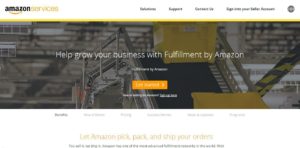
For many Amazon sellers, Amazon’s Fulfillment by Amazon (FBA) program is where it’s at.
This program offers storage, packing, and shipping services; and also handles customer service issues – including returns. FBA also helps to make sellers more visible to Prime members; an especially valuable customer base considering that Amazon Prime members spend almost twice as much as regular buyers.
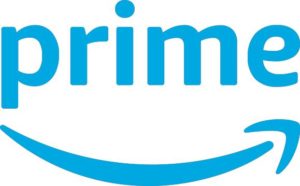
But while FBA can be a great way to drive more sales, there are some drawbacks to using this program as well. For one thing, sellers have to ship their products to Amazon and pay for storage, which can get real expensive real fast if things don’t shift quickly. Also, there are much higher fees for Amazon sellers who use FBA as well.
Let’s look at both the pros and cons now.
Pros of FBA
There are a number of pros to selling via FBA.
First, the most obvious benefit: time. With FBA, you’ll be able to outsource all of the packing, labeling, and shipping. Amazon will also handle all of the customer service as well.
The main one, being access to Amazon Prime members. Since Prime members tend to choose Prime-eligible products, you’ll gain greater visibility if you go this route. Additionally, since Prime members spend almost twice as much as non-Prime members, this can prove to be extremely profitable.
With FBA, you’re also more likely to win the much-sought-after Buy Box –the box on the product detail page where customers can begin the purchasing journey. FBA sellers will secure the Buy Box over a self-fulfilled seller most of the time; giving you a chance to drastically increase your sales.
Finally, with FBA, you’ll also be able to leverage Amazon’s supply chain infrastructure. Few independent sellers can compete on this level, but with FBA, you can.
Cons of FBA
Now, a look at some of the cons of FBA.
Amazon charges significant fees for using FBA. For large items, or stock that takes a while to shift, shipping and storage can quickly add up. In most cases, it doesn’t make a lot of sense to use FBA for items that won’t sell quickly. Here’s a good rundown on all of the fees that you can expect using this service. These include everything from picking and packing your orders, shipping and handling, customer service, product returns, and storage per cubic foot per month.
You also lose a lot of control with the order and fulfillment process, which can be risky. Because Amazon tends to store the same items together in inventory, there’s a good chance that a customer that orders your product won’t receive the exact one that you sent in.
There’s also a chance that other sellers, may send in the “same items,” that are counterfeit or lower quality –which your customers could end up with. What’s more is there have reportedly been cases where Amazon sellers have been penalized for faulty products shipped out via FBA.
So what’s the verdict? For busy e-commerce stores who are looking to outsource much of the work, FBA could be a great idea. Just make sure you understand the potential risks before you start. And ensure that you can still turn a profit, even with the higher fees.
Be Careful Relying Solely on Amazon

So is Amazon the place for sellers to be?
It depends!
At the end of the day each platform will have its own set of pros and cons, advantages that make it better for some, or factors that make it a no-go for others.
With Amazon, the main thing to remember is that you don’t own your storefront. You don’t get to make the rules, and you have to play by theirs. And while it’s somewhat unlikely, there’s always a chance that your products, or company could be banned or your shop shut down.
I’ve experienced something similar to this myself.
After a couple years in business, things got to the point where 90% of my website visitors came via organic search traffic from Google. Everything was going great –until Google released an algorithm update and BAM we lost 20% of our traffic in one day! We were able to get it back –eventually, but it was a wakeup call to me that we needed to diversify as much as possible so that no single traffic source could take down the company.
It’s the same with Amazon. It’s important to diversify so that you are never reliant on one source of traffic or sales –whether that be Amazon, organic ranking on Google, or Facebook Ads.
All of this to say, when it comes to Amazon, you may find that you have more piece of mind diversifying, and working towards creating your own storefront.
“Amazon is where the traffic is, it’s the proverbial big pond and once it’s much easier to make sales there than on some new website you built, Shopify or otherwise,” writes Dan Moody, founder of Private Label, Selling on Amazon fba.
“But amazon is so good, it makes sellers lazy and complacent,” he continues. “This isn’t a big issue when you just have a couple of grand in the game, but when you sell 10,20, 30k plus per month and more, you’re building a house of cards that can be wrecked by a few fake reviews or false safety claims by competitors.”
Amazon can be a great platform –in terms of reach, you can’t beat it, and there’s the opportunity for savvy sellers to make tremendous money on it. But the downside is that you will face stiff competition, potentially high fees, minimal chance to grow your own brand, and of course, you’re at their mercy should they decide to deactivate your account.
With your own platform, or even a Shopify account, you have a lot more control over your brand, business, and ultimate growth –although you’ll have to work a lot harder to bring in traffic and make sales.
So what’s the verdict? Amazon or your own platform? Ultimately, you may find that the best option is both! Consider taking advantage of Amazon’s extensive reach –while at the same time, working to grow your own business. This will enable you to benefit from immediate sales, while at the same time allowing you to work on your long-term strategy –collecting email addresses, growing your customer base, and working on building a brand that has staying power.
E-commerce store owners, what’s your platform of choice?

Get our Is Amazon Still the Best Place to Start Selling Worksheet delivered right to your inbox.
